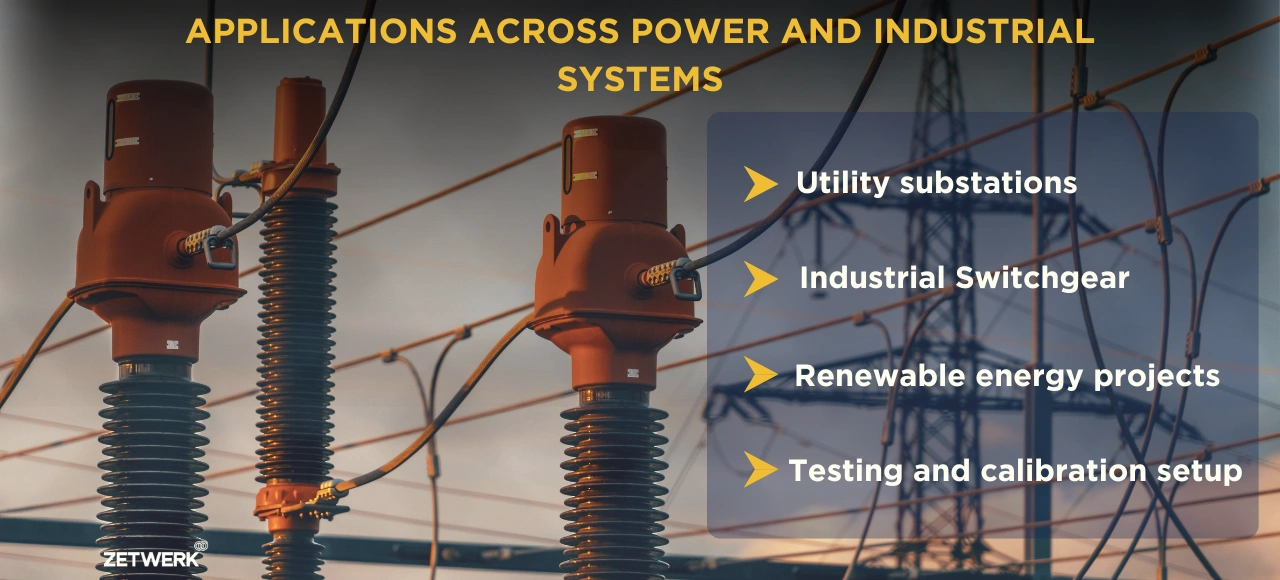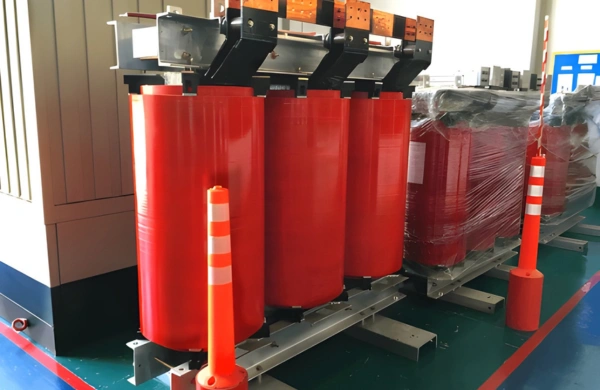In every power network, accuracy and reliability start with precise measurement. Whether in substations, generation plants, or industrial switchyards, potential transformers (PTs)—also known as voltage transformers (VTs)—are essential for safe, stable, and efficient grid operation.
These devices ensure that high-voltage signals are accurately scaled down for metering and protection systems. For EPCs, utilities, and equipment integrators, the quality of a potential transformer determines the accuracy of the entire control and monitoring infrastructure.
This is where Zetwerk delivers measurable value engineering precision, advanced manufacturing, and verified testing to produce PTs built for long-term reliability and compliance.
Know About Building Reliable Potential Transformers
with Zetwerk
Purpose of Potential Transformers in Power Systems
A potential transformer is designed to reduce high system voltages to standardized lower values (typically 110V or 120V), allowing safe operation of instruments and relays.
They serve three essential functions in power systems:
- Voltage Measurement: Accurate voltage scaling for meters and recorders.
- Protection: Supplying precise voltage to protection relays for system stability and fault isolation.
- Isolation: Providing galvanic separation between high-voltage circuits and control systems, enhancing safety.
In modern grids, where automation and reliability are paramount, potential transformers form the foundation of monitoring accuracy and protection performance.
Zetwerk’s Engineering Approach to Potential Transformer Design
Zetwerk designs potential transformers with a clear objective—precision that endures. Each unit is engineered using advanced tools and proven material combinations to ensure performance under dynamic load and environmental conditions.
Core Design and Materials
Zetwerk uses high-grade cold-rolled grain-oriented (CRGO) steel or amorphous alloy cores depending on accuracy class and loss requirements.
- Low core losses for energy efficiency
- Stable magnetic characteristics for consistent performance
- Optimized flux density to minimize ratio and phase errors
Winding & Insulation System
Each PT is wound with electrolytic copper conductors insulated using Class A or Class F insulation materials.
- Precise layer construction ensures low leakage reactance.
- Enhanced insulation coordination prevents dielectric stress during transient overvoltages.
Thermal & Mechanical Design
Zetwerk engineers design for long service life under temperature fluctuations and system vibrations.
- Oil-filled or cast resin insulation options are available.
- Tanks and bushings are designed for mechanical stability and ease of maintenance.
Testing and Calibration
Every transformer undergoes type, routine, and special tests as per IS 3156 and IEC 61869-3 standards:
- Ratio and polarity verification
- Accuracy class testing (0.2, 0.5, 1.0 as required)
- Insulation resistance and dielectric strength
- Impulse voltage and temperature rise tests
This comprehensive testing framework ensures each PT performs precisely under rated voltage and frequency conditions.
Manufacturing Excellence that Ensures Reliability
Zetwerk’s transformer facilities are equipped with advanced machinery and digital quality systems that guarantee consistency across every unit produced.
- Precision Core Fabrication
Automated core cutting and stacking ensure magnetic uniformity and reduced losses.
- Vacuum Drying & Oil Processing
For oil-immersed PTs, controlled vacuum drying and degassing enhance insulation life and dielectric strength.
- Epoxy Casting & VPI Process
For dry-type units, vacuum pressure impregnation (VPI) and cast resin processes ensure mechanical robustness and moisture resistance—ideal for indoor or coastal installations.
- Digital Traceability
All materials and production parameters are digitally logged, providing full traceability from raw material to finished unit—a key requirement for EPC audits and QA documentation.
Standards and Quality Compliance
Zetwerk manufactures potential transformers conforming to:
- IS 3156 (Parts 1 to 4) – Instrument Transformers
- IEC 61869-3 – Voltage Transformers
- IEEE C57.13 – U.S. standard for Instrument Transformers
Each unit comes with comprehensive documentation, including routine test certificates, dimensional drawings, and guaranteed technical parameters.
Applications Across Power and Industrial Systems


Zetwerk’s potential transformers are deployed across various sectors:
- Utility substations: For voltage measurement, metering, and protection relays.
- Industrial switchgear: Providing accurate secondary voltage to monitoring systems.
- Renewable energy projects: Used in solar and wind substations to ensure grid compliance.
- Testing and calibration setups: Used in electrical testing labs and protection panels.
Their robust construction and precision calibration ensure dependable service across these diverse environments.
Innovation and Customization
Unlike off-the-shelf units, Zetwerk’s PTs are custom-engineered to meet each client’s specific voltage class, insulation level, and accuracy requirement.
Custom Options Include:
- Primary voltage up to 66 kV (extendable based on project scope)
- Accuracy classes: 0.1, 0.2, 0.5, or 1.0
- Frequency: 50 Hz or 60 Hz
- Insulation: Oil-immersed or dry-type resin cast
- Mounting: Indoor/outdoor enclosures, wall or pedestal mount
- Terminal arrangements customized to control panel or relay requirements
This flexibility enables EPCs and utilities to integrate Zetwerk PTs seamlessly into their systems—reducing installation complexity and maintenance downtime.
Quality Assurance and After-Sales Support
Zetwerk’s responsibility doesn’t end at dispatch. Every transformer is backed by technical documentation, warranty support, and responsive after-sales service.
- Factory Acceptance Tests (FATs) are available for customer witnessing.
- On-site installation and commissioning guidance.
- Lifecycle maintenance recommendations to ensure sustained accuracy.
This holistic service model makes Zetwerk a reliable partner, not just a component supplier.
Conclusion
Accurate voltage measurement is the cornerstone of safe and efficient power systems. With rising energy demands and automation, potential transformers play a critical role in ensuring stability, precision, and protection across grids and industries.
Zetwerk combines advanced engineering, controlled manufacturing, and certified testing to deliver PTs that meet the highest global standards. Each Zetwerk transformers reflect precision design, durability, and consistent performance—proven across industrial and utility environments.




If your project demands precision-built, reliable potential transformers, partner with Zetwerk—where innovation, engineering integrity, and manufacturing excellence power every connection.
FAQs
A. It steps down high voltage to a standard measurable level for metering, control, and protection circuits.
A. Common accuracy classes include 0.1, 0.2, 0.5, and 1.0—depending on measurement precision required.
A. Yes. They are designed for solar and wind substations, supporting accurate grid monitoring and energy accounting.
A. All PTs are manufactured and tested per IS 3156, IEC 61869-3, and IEEE C57.13 standards.
A. Yes. Zetwerk manufactures both variants, depending on site conditions and client specifications.







